| |
Glossary of Coral Reef Terminology - D
dacriform - tear-drop shaped |
dactylozooid - a colonial hydrozoan polyp that possesses a large, nematocyst-bearing fishing tentacle, and functions in defense and in food capture |
Dalton's Law - the total pressure exerted by a mixture of gases is the sum of the pressures that would be exerted by each of the gases if it alone were present and occupied the total volume |
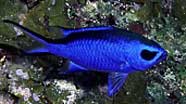
One of the prettier damselfishes, the blue chromis (Chromis cyanea), swimming on a hawaiian coral reef (Photo: Keoki and Yuko stender)
|
damselfish - a large family (Pomacentridae) of bony fishes which are abundant and common inhabitants of coral reefs. They possess robust, deep, and laterally compressed bodies. The majority of damselfishes do not have particularly brilliant markings or coloration. Exceptions are the brilliantly colored anemone fishes, the banded sergant major, and the bright orange garibaldi, Many species of damselfishes are highly territorial |
dark-field microscope - a microscope that has a special condenser and objective with a diaphragm that scatters light from the observed object. The object appears bright on a dark background |
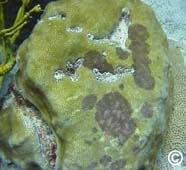
Dark spots disease infecting Stephanocoenia intersepta. (Photo: NOAA; image copyrighted)
|
dark-spots disease - a coral disease characterized by darkly pigmented areas of tissue on stony corals.-At present, there is no known pathogen. The coral tissue remains intact, although at times lesions and coral tissue death are observed in the centers of the pigmented areas. Tissue loss is minimal, if present. This disease is widespread throughout the Caribbean.-For additional information and illustrations, see: http://www.coral.noaa.gov/coral_disease/dark_spots.shtml |
dart - a structure of an invertebrate animal that pierces or wounds; a small, narrow-pointed missile that is thrown or shot |
darwin - a logarithmic unit measuring the rate of evolution in characteristics of organisms |
Darwin medal - the most prestigious award given by the International Society for Reef Studies (ISRS), presented every four years at the International Coral Reef Symposium. It is awarded to a senior ISRS member who is recognized worldwide for major contributions throughout their career |
Darwin Mounds - two areas of hundreds of sand and cold-water coral mounds at depths of about 1,000 m, in the northeast corner of the Rockall trough, approximately 185 km northwest of the northwest tip of Scotland. The Darwin Mounds cover an area of approximately 100 sq. km. The tops of the mounds are covered with Lophelia pertusa corals and coral rubble |
Darwin point - the latitude at which reef growth just equals reef destruction by various physical forces |
Darwinian evolution - evolution of life forms by the process of natural selection acting on random genetic variations |
data - multiple facts (usually but not necessarily empirical) used as a basis for inference, testing, models, etc.; the word is plural (sing. datum) and takes a plural verb |
data management - the act, process, or means by which data are managed. This includes the planning, collection, compilation, archival, safe-guarding, listing, organization, extraction, retrieval, manipulation, and dissemination of data |
data management and observing system interoperability - the ability of two or more systems to exchange and mutually use data, metadata, information, or system parameters using established protocols or standards |
data management services - a subset of data management and includes adherence to agreed-upon standards; ingesting data, developing collections, and creating products; maintaining data bases; ensuring permanent, secure archival; providing both user-friendly and machine-interoperable access; assisting users; migrating services to emerging technologies; and responding to user feedback |
data mining - an information extraction activity whose goal is to discover hidden facts contained in databases. Using a combination of machine learning, pattern recognition, statistical analysis, modeling techniques and database technology, data mining finds patterns and subtle relationships in data and infers rules that allow the prediction of future results |
data stewardship - a subset of data management and consists of the application of rigorous analyses and oversight to ensure that data sets meet the needs of users. This includes documenting measurement practices and processing practices (metadata); providing feedback on observing system performance; inter-comparison of data sets for validation; reprocessing (incorporate new data, apply new algorithms, perform bias corrections, integrate/blend data sets from different sources or observing systems); and recommending corrective action for errant or non-optimal operations |
data warehouse - a database, frequently very large, that can access vast arrays of heterogeneous data, stored within a single logical data repository, that are accessible to different querying and manipulation methods . While the warehouse can be distributed over several computers and may contain several databases and information from numerous sources in a variety of formats, it should be accessible through a server. Thus, access to the warehouse is transparent to the user, who can use simple commands to retrieve and analyze all the information. The data warehouse also contains data about how the warehouse is organized, where the information can be found, and any connections between data. Frequently used for decision support within an organization, the data warehouse also allows the organization to organize its data, coordinate updates, and see relationships between information gathered from different parts of the organization |
database - a structured file of information or a set of logically related data stored and retrieved using computer-based means |
database management system (DBMS) - a set of computer programs for organizing the information in a database. A DBMS supports the structuring of the database in a standard format and provides tools for data input, verification, storage, retrieval, query, and manipulation |
daughter cell - one of the two cells formed by the division of a parent cell |
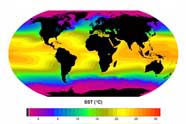
1985-2000 average sea surface temperature from AVHRR Pathfinder.
|
Day/Night SST - observations of sea surface temperature obtained during both daytime and nighttime orbits from the Advanced Very High Resolution Radiometer (AVHRR) on NOAA's polar satellite |
de facto - in fact; in reality; existing but not officially recognized or legally established |
dead ahead - a position directly in front of a vessel |
dead zone - hypoxic (low-oxygen) areas in the world's oceans and in some large lakes where all or most life forms are unable to survive. Dead zones can be caused by an increase in chemical nutrients (primarily nitrogen and phosphorus) in the water. Chemical fertilizer is considered the prime cause of dead zones around the world. A prominent dead zone in North America is an approximately 22,126 km2 (8,543 mi²) region in the Gulf of Mexico, where the Mississippi River discharges high-nutrient runoff from its large drainage basin. Sizes of dead zones fluctuate seasonally, being affected by agricultural practices and weather events |
decadal - refers to a climatic process that re-occurs every decade or once every few decades |
decalcification - the loss of calcium salts from living tissues |

A spider crab is a decapod crustacean.
|
decapod crustacean - a members of the Order Decapoda, Class Malacostraca, Superclass Crustacea, Phylum Arthropoda; has five pairs of thoracic legs. Examples are shrimps, lobsters, crabs, and hermit crabs |
decibel - a logarithmic scale used to denote the intensity (loudness), of a sound relative to the threshold of human hearing. A step of 10 dB is a 10-fold increase in intensity or sound energy |
decibel - unit for measuring sound intensity |
deciduous - periodically shed |
decomposer - a heterotrophic organism that breaks down dead biological matter and uses some of the products and releases others for use by consumer organisms |
decomposition - the breakdown of organic matter by bacteria and fungi |
decompression - a change from one ambient pressure to a lower ambient pressure as the scuba diver ascends. Decompression also occurs in a decompression chamber. Decompression results in a reduction of gas pressures within the body |
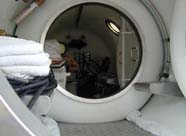
A NOAA decompression chamber.
|
decompression chamber - a hyperbaric steel enclosure used to treat victims of decompression sickness (the "bends") in which the air pressure is first gradually increased and then gradually decreased. This shrinks the nitrogen bubbles and allows the nitrogen to safely diffuse out of the victim's tissues |
decompression dive - any dive where the scuba diver is exposed to a higher pressure than when the dive began. Decompression occurs as the diver ascends |
decompression diving - scuba diving that requires in-water stops during ascent to the surface to allow off-gassing of nitrogen |
decompression sickness (the bends) - a dangerous and potentially lethal condition of divers precipitated by rapid changes in ambient atmospheric pressure, mostly in rapid ascent from underwater, but can also result from flying in an aircraft too soon after a dive. It occurs because at high pressures (such as SCUBA divers experience while underwater) the blood can contain more dissolved nitrogen than at lower pressures. When the diver ascends too rapidly, the blood can no longer contain this dissolved nitrogen and tiny gas bubbles begin to form in the blood. Symptoms include: body pain (mainly in the joints), headache, confusion, itchy skin rash, visual disturbances, weakness or paralysis, dizziness, or vertigo. treatment involves the administration of oxygen and placing the patient into a decompression chamber until the nitrogen bubbles shrink and safely diffuse from the tissues |
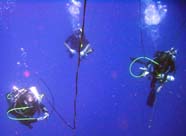
These NOAA divers are making a decompression stop to allow nitrogen to escape from their tissues. (Photo: NOAA/National Marine Fisheries Service)
|
decompression stop - a specified time spent at a specific depth as a scuba diver ascends from a dive for purposes of releasing nitrogen gas from the tissues (nitrogen off-gassing) |
deductive reasoning - an inference in which the conclusion about particulars follows necessarily from general theory. In science, deductive reasoning would involve stating an hypothesis first, and then trying to find facts that reject the hypothesis |
deep fore reef - the deepest seaward part of a coral reef; a vertical cliff beginning at a depth of about 60 m |
deep scattering layer - a thin sound-reflecting layer of zooplankton and nekton that ascends toward the surface at night and descends each day (diurnal vertical migration) in response to changing levels of light |
deep water - the water beneath the permanent thermocline that usually has a low and uniform temperature |
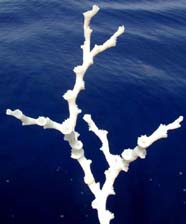
Lophelia pertusa, a deep-sea stony coral.
|
deep-sea corals - stony, soft, gorgonian, black, and horny corals that inhabit the colder deep waters of continental shelves and offshore canyons, ranging from 50 -1000m+ depths. They lack zooxanthellae and may build reef-like structures or occur solitarily |
definitive host - in a parasite's life cycle, it is the host organism in which the parasite reproduces sexually |
deforestation - the removal of trees from a habitat dominated by forest |
degeneracy - in relation to the genetic code, more than one codon can code for the same amino acid |
degenerate character - a character, trait or structure that has evolved to a less developed state from its ancestral form or function |
degenerate code - the genetic code in which more than one triplet of nucleotides codes for the same amino acid |
degeneration - a process by which tissue deteriorates, loses functional activity, and may become converted into or replaced by other kinds of tissue; deterioration which causes some degree of loss of original function; the process of declining from a higher to a lower form |
degradation - the breaking down of a substance into smaller or simpler parts |
Degree Heating Week (DHW) - the NOAA satellite-derived Degree Heating Week (DHW) is an experimental product designed to indicate the accumulated thermal stress that coral reefs experience. A DHW is equivalent to one week of sea surface temperature 1 deg C above the expected summertime maximum. For example, 2 DHWs indicate one week of 2 deg C above the expected summertime maximum |
Degree Heating Week accumulation - accumulated thermal stress that coral reefs experience over a typical 12-week period |
degrees of freedom - in statistics, the number of independent comparisons that can be made between the members of a sample; in a contingency table it is one less than the number of row categories multiplied by one less than the number of column categories. The number of degrees of freedom is defined as the number of observations that can be chosen freely, i.e., an estimate of the number of independent categories in a particular statistical test or experiment |
deimatic behavior - defensive postures or other visual displays, including color changes, that function to intimidate or frighten another animal |
delayed fertilization - when fertilization of an egg does not occur immediately following introduction of spermatozoa into the female reproductive tract, but may be delayed for weeks or months |

Nile River delta, as seen from Earth orbit. (Photo: NASA)
|
delta - the fan-shaped area at the mouth or lower end of a river formed by eroded material that has been carried downstream and dropped in quantities larger than can be carried off by tides or currents |
delta notation - the absolute abundance of an isotope is difficult to measure with accuracy. Therefore, we compare isotopic ratios in a sample with those in a standard resulting in the delta-notation: d(x) = [{Rx - Rst}/Rst] x 103, where d(x) is the delta-value of a sample, Rx and Rst are the isotopic ratios in sample (Rx) & standard (Rst). The d-value is the relative difference in the isotopic ratio of the sample and the standard. It is expressed in part per mille (o/oo); that is why the right-hand side of the equation is multiplied by 103 (1000). Carbon and oxygen data from carbonates are usually referred to the PDB standard (a belemnite, Belemnitella americana, from the Late Cretaceous PeeDee Formation in South Carolina) |
delta plain - a nearly horizontal portion of a delta which during low tide is largely exposed to the atmosphere |
deme - a local interbreeding population of a species |
demersal - pertains to an organism that is essentially bottom living but may feed and swim in the water column |
demography - the rate of growth and the age structure of populations, and the processes that determine these properties |
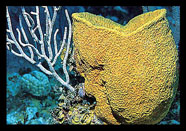
A yellow barrel sponge in the class Demospongiae (Photo: Rick Gillis)
|
Demospongiae - a class of asymmetrical sponges (phylum Porifera) which range in size from a few millimeters to over two meters in largest dimension. They are composed of spongin fibers alone or together with siliceous spicules that are differentiated into megascleres (larger size) or microscleres (smaller size) of diverse shapes. The class includes approximately 5000 species in 10 orders. They are the most diverse group of sponges and only exhibit the leuconoid grade of construction. Their geographic distribution in the oceans is from the intertidal to the abyssal zone. Some species inhabit freshwater. Their shapes include thin encrustations, lumps, finger-like growths, or urns. Pigment granules in amoebocytes often make members of this class brightly colored, including bright yellow, orange, red, purple, or green. The most economically important group are the bath sponges |
denaturation - the inducing of structural alterations that disrupt the biological activity of a molecule. It often refers to breaking hydrogen bonds between base pairs (by heat) in double-stranded nucleic acid molecules to produce single-stranded polynucleotides, or altering the secondary and tertiary structure of a protein, destroying its activity |
denatured alcohol - ethyl alcohol (ethanol) to which a poisonous substance, such as acetone or methanol, has been added to make it unfit for consumption |
denaturing gradient gel electrophoresis (DGGE) - a method for separating DNA fragments according to their mobilities under increasingly denaturing conditions |
dendriform - having a structure that resembles a tree or shrub |
dendrite - a sensory branch of a neuron that carries a nervous inpulse to the cell body |

Black coral is dendritic in shape. (Photo: Waikiki Aquarium)
|
dendritic - branched like a tree |
dendrogram - a branching tree-like diagram used to represent phylogenetic paths of evolution |
denitrification - the formation of gaseous nitrogen and/or nitrogen oxides from nitrate or nitrite by denitrifying bacteria during anaerobic respiration |
denitrify - to remove nitrogen from any substance or chemical compound |
denitrifying bacteria - anaerobic bacteria in soil or water that use the nitrate ion as a substitute for molecular oxygen during their metabolism. The nitrate is reduced to nitrogen gas (N2), which is lost to the environment during the process |
dentate - having teeth or tooth-like points; serrate |
denticle - a little tooth |
denticulate - having an edge with small projecting teeth |
deoxyribonucleic triphosphates - unreactive nucleotides that closely resemble the nucleotides that make up DNA. They are 'dummy' nucleotides that act as placeholders when DNA is sequenced |
depauperate - an area poor in species richness and/or biodiversity; an impoverished habitat |
dependent species - a species dependent on another for survival, e.g., a predator on a prey, a commensal or other kind of symbiont |
dependent variable - the variable being measured |
deposit - material left in a new position by a natural transporting agent, such as water, wind, ice, or gravity, or by human activity |
deposit feeder - an animal that feeds on nutrients in the sediments |
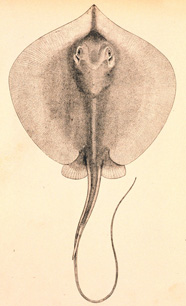
The southern stingray has a depressed body shape. (Illustration: NOAA)
|
depressed - a body shape which is flattened dorso-ventrally, e.g., a ray, skate, monkfish |
depth contour - a line on a nautical chart connecting points of equal depth |
derived character - in evolution, an advanced trait which only appears in some members of a taxonomic group. For example,a derived character for some mammals would be the loss of the tail, which occurs in the great apes and man. Another derived character is the presence of feathers in birds. Scales are the ancestral feature. Derived characters are also called apomorphies |
dermal - pertaining to or affecting the skin |
dermal flap - a small skin flap |
dermis - the layer of the skin beneath the epidermis. The dermis is largely fibrous and contains collagen and elastin which are the proteins responsible for the support and elasticity of the skin. Depending upon the species, the dermis also contains tiny sensory nerve endings, blood and lymph vessels, and sweat and sebaceous glands |
dermochelyid sea turtle - a leathery-shelled turtle in the family Dermochelyidae. The leatherback turtle (Dermochelys coriacea) is the only dermochelyid sea turtle. All other species of sea turtle belong to the family Cheloniidae. Dermochelys coriacea is a federally endangered species protected under the Endangered Species Act |
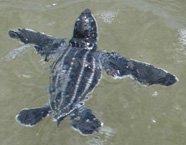
This leatherback turtle hatchling belongs to the turtle family, Dermochelyidae. (Photo: S.R. Livingstone, University of Glasgow)
|
Dermochelyidae - a family of marine turtle that contains only a single species, the leatherback turtle (Dermochelys coriacea), the largest of all extant turtles. They are carnivorous, feeding almost exclusively on jellyfish |
desalinization - the removal of salts from saline water to provide freshwater |
designated Use - classification specified in water quality standards for each waterbody or segment describing the level of protection from perturbation afforded by the regulatory programs. The designated aquatic life uses established by the state or authorized tribes set forth the goals for restoration and/or baseline conditions for maintenance and prevention from future degradation of the aquatic life in specific waterbodies |
desmocyte - a connective tissue cell which differentiates into cells which form the fibrous and supporting tissues of an animals's body; also called a " fibroblast"; in corals, an anchoring cell of the calicoblastic epithelium or axis epithelium of gorgonians |
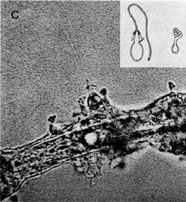
The desmoneme of the hydrozoan Hydra vulgaris. (Photo: Alfred H. Gitter)
|
desmoneme - in hydrozoans, a small nematocyst with a short, unarmed, spirally coiled tubule, which functions in entangling and wrapping around appendages or bristles of prey animals |
destruction resuspension - the process in which sediment particles on the substrate are brought back into water column suspension by waves, tides, or wind |
determinate cleavage - cleavage resulting in blastomeres each capable of developing only into a particular embryonic structure, not into a complete organism |

Low tide along South Carolina shoreline with bits of sea shells and other detritus (Photo: Richard B. Mieremet, NOAA)
|
detritus - the particulate decomposition or disintegration products of plankton, including dead cells, cell fragments, fecal pellets, shells, and skeletons, and sometimes mineral particles in coastal waters |
detritus food chain - a trophic relationship among a variety of species that is sustained at its base by organisms that gather bits of nonliving organic material |
detrivore - an animal that eats detritus |
deuterostome - one of two distinct evolutionary lines of coelomates, consisting of the echinoderms and chordates and characterized by radial cleavage of the early embryo. The cleaving cells are indeterminate (if early embryonic cells are separated, each one develops into a complete organism). The anus develops from the blastopore |
developed country - describes nations or countries with social, cultural, industrial and technological advancement |
developing country - describes regions and countries that are still in the process of acquiring modern technology and becoming economically productive. These regions are sometimes called the “Third World” |
development - the chronological series of changes, from a lower to a higher state of organization, which multicellular organisms undergo from the fertilized egg (zygote) to maturity |
developmental response - morphological and physiological characteristics an organism developed in response to prolonged exposure to environmental conditions |
deviation - in statistics, the difference between an actual observation and the mean of all observations |
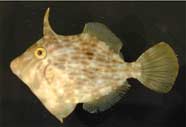
Filefishes possess prominent dewlaps on their throat-breast region (Photo: NOAA)
|
dewlap - a fold of loose skin |
dextral - right, as opposed to sinistral, or left |
diadromous species - a species which undertakes a spawning migration from ocean to river or vice versa |
diagenesis - all of the changes that occur to a deposited sediment during its conversion to rock; includes changes that result from chemical, physical as well as biological processes |
diagnosis - identifying the nature or cause of some phenomenon; in pathology, (1) the act or process or deciding the nature of a disease by examination and observation, (2) a careful investigation of the facts to determine the nature of a thing, and (3) the decision resulting from either of these |
diagnosis, clinical - a diagnosis based upon signs and laboratory analyses while the organism is alive |
diagnosis, definitive - the name of a disease or pathological condition, as in “white plague” |
diagnosis, differential - in taxonomy, a statement of the characters that distinguish a given taxon from other, specifically mentioned equivalent taxon; the process of identifying a pathological condition by differentiating all pathologic processes that may produce similar lesions |
diagnosis, etiological - a diagnosis reflecting identification of the cause or causative agent of a disease |
diagnosis, morphological - a diagnosis based upon a description of the alteration of form or structure of the tissues or organs, usually at the gross, histological, cellular or subcellular level |
diagnosis, physical - a diagnosis based on information obtained by inspection or palpation (feeling with the hand) |
diagnosis, presumptive - an unconfirmed diagnosis based on interpretation of initial and incomplete information |
diagnostic characters - in taxonomy, the characters, or most important characters, which distinguish a taxon from other similar or closely related taxa |
diapause - a state of arrested development or growth, accompanied by greatly decreased metabolism |
diaphanous - thin and translucent; semi-transparent |
diastema - a space; a gap |
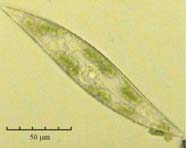
A living diatom (Pleurosigma angulatum) from Arctic seas.
|
diatom - a unicellular alga that consists of two interlocking valves composed of silica |
diatomaceous - pertaining to diatoms or their fossil remains |
dichopatric - pertains to allopatric populations with non-contiguous ranges |
dichopatric speciation - a type of speciation in which a formerly contiguous population is split by the rise of some geographical barrier, e.g., a mountain range |
dichotomous key - a tool to help identify taxa. It is made up of pairs of choices. Each choice is between statements describing specific traits of the taxa under consideration. Only one statement will be true for each choice. Each choice points to another set of choices until finally only one choice remains |
diel - a 24-hour period that usually includes a day and its adjoining night; pertaining to the day-night cycle |
differential diagnosis - see "diagnosis, differential" |
diffusion - the movement of particles from a region of higher concentration to a region of lower concentration |
digestion - the breakdown, by hydrolysis, of complex ingested nutrient compounds (carbohydrates, fats, proteins) into their building blocks, i.e., the conversion of food, in the alimentary canal, into soluble and diffusible products, capable of being absorbed into the circulating fluid and the cells |
Digital Versatile Disc (DVD) - an advanced type of CD-ROM that holds a minimum of 4.7 gigabytes (unit of storage) to a maximum of 17 gigabytes of information. They are compressed using the MPEG codec, which stores only the changes from one frame to another instead of the entire frame |
digitiform - finger-shaped |
dimorphism - having two different distinct forms of individuals within the same species or two different distinct forms of parts within the same organism. It could refer to different colors or color patterns, sizes, anatomical parts, etc. Sexual dimorphism is a common case, where the two sexes have different shapes, sizes, etc. |
dinghy - a small open boat |
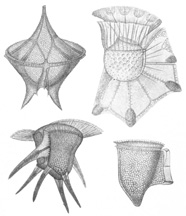
Diverse shapes of planktonic dinoflagellates in tropical Atlantic waters. (Illustration: NOAA)
|
dinoflagellate - a unicellular, generally motile, chiefly marine protist with two whip-like flagella. Some autotrophic species, called zooxanthellae, are endosymbionts of corals and other invertebrates. Dinoflagellates are probably best known as a principal cause of marine bioluminesence, "red tides" and paralytic shellfish poisoning |
dioecious - having separate sexes. Individuals within the species contain only one or the other of male and female reproductive systems |
diopter - a metric unit used in optics to measure the refractive power of a lens |
dioxin - a chlorinated organic chemical byproduct (dibenzo-p-dioxins), released into the environment from incineration and during industrial processes that use chlorine. Dioxins are highly toxic and can have immediate and long-term health effects, including skin disease, cancer, and reproductive failure |
dip net - a small mesh bag, sometimes attached to a handle, shaped and framed in various ways. It is operated by hand or partially by mechanical power to capture specimens |
diphycercal - a caudal fin shape which is primitively symmetrical and pointed, and with the vertebral column or notochord extending to the tip, as found in primitive fishes, such as lampreys and chimaeras |
diploid - the condition in which a cell contains a nucleus with two complete sets of chromosomes, one set inherited from each parent. The diploid condition is often abbreviated as 2n. Most plants and animals are diploid. The term also represents the number of chromosomes in most cells except the gametes, which are haploid in chromosome number |
direct sun - refers to a measurement based only on direct radiation from the sun's disk and excluding indirect radiation from the remainder of the sky |
directed fishing - fishing that is targeted at a certain species or group of species. This applies to both commercial and sport fishing |
directional asymmetry - a pattern of deviation with a side bias. A side difference occurs for a given trait, with the larger side generally the same among individuals; the right minus the left value of a trait |
directional selection - a type of natural selection that removes individuals from one end of a phenotypic distribution and thus causes a shift in the distribution. The frequency of an allele is changed in a constant direction, either toward or away from fixation for that allele. Directional selection occurs when individuals at one phenotypic extreme have an advantage over individuals with more common phenotypes |
disaccharide - a sugar (carbohydrate) formed by the covalent bonding of two monosaccharides. Table sugar, sucrose, is a disaccharide |
disciform - round or oval-shaped |
discodermolide - a marine pharmaceutical isolated from deep-water sponges of the genus Discodermia. Discodermolide possesses immuno-suppressive and anticancer properties which inhibit cell division by interfering with the cell's microtubule network |
discoidal - disc-shaped; flat and round shape |
discrete probability distribution - a probability distribution is called discrete if its cumulative distribution function only increases in jumps; a probability distribution is discrete if there is a finite or countable set whose probability is 1 |
discrimination - differential response to different stimuli |
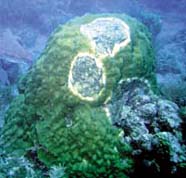
Coral with yellow band disease, which results in serious losses of coral tissue.
|
disease - any impairment of an organism's vital functions or systems, including interruption, cessation, proliferation, or other malfunction |
disease vector - an organism which transmits infective organisms from one host to another |
disjunct - distinctly separate; disjunct populations are populations separated from other potentially interbreeding populations by a distance large enough to prevent exchange of genetic materials |
disjunct distribution - the discontinuous or separated geographical distribution of a species or other taxonomic unit |
dispersal - the spread of a species to a new location. In many organisms, this happens at a particular stage in the life cycle, and is often critical for the species' survival. Organisms may disperse as spores, seeds, eggs, larvae, juveniles, or adults |
disphotic zone - the part of the water column that is barely illuminated by sunlight from above; the "twilight zone" between the photic and aphotic zones |
displacement behavior - a behavioral response that is appropriate for one situation appears in another situation, for which it is inappropriate |
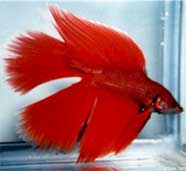
An agonistic display by the male Siamese fighting fish, Betta splendens. (Photo: Jennifer Beavin)
|
display - in animal behavior, visual messages or body language, used by animals primarily to communicate anger, fear, and other basic emotions. Displays are strong indications of an animal's emotional state |
Disputed Island - formerly or currently considered U.S. possession by the U.S. The U.S., through negotiation, has disclaimed ownership of most islands in favor of another country. Two islands remain contested |

The color pattern of the juvenile spotted drum, Equetus punctatus, is an example of disruptive coloration. (Photo: Dr. Tom Doeppner, Brown University)
|
disruptive coloration - a color pattern that breaks up the outline of an organism |
disruptive selection - natural selection that favors individuals that deviate from the population average. For example, positive selection which favors individuals that are larger or smaller than average |
dissepiment - a horizontal partition within or outside of a corallite |
dissociation - the temporary or reversible chemical process in which a molecule or ion is broken down into smaller molecules or ions |
dissolved oxygen - the concentration of oxygen dissolved in water, expressed in mg/l or as percent saturation, where saturation is the maximum amount of oxygen that can theoretically be dissolved in water at a given temperature and pressure |
distal - the direction away from the midline of the body; the opposite of proximal |
distant linked habitats - connected environments that are intended to conserve "all" biodiversity in an area- typically large and usually include both aquatic and terrestrial targets |
distinct - clearly defined and easily recognized |
distinct population segment - "population," or "distinct population segment," are terms with specific meaning when used for listing, delisting, and reclassification purposes to describe a discrete vertebrate stock that may be added or deleted from the list of endangered and threatened |
distribution - the area where a species is known to occur |
disturbance - any relatively discrete event in time that disrupts ecosystem, community, or population structure and changes resources, substrate availability, or the physical environment; an event or change in the environment that alters the composition and successional status of a biological community |
disulfide bond - a chemical bond between the sulfur atoms of two different amino acids in a protein |
diurnal - active during the day light hours |
dive computer - a small electronic sensor and calculator, carried by the scuba diver, that calculates and displays the basic information needed during a dive, i.e., depth, time, decompression status and tank pressure. By constantly monitoring depth and bottom time, dive computers automatically recalculate the diver's no-decompression status, giving longer dive times while still keeping the diver within a safe envelope of no-decompression time. Computers also monitor ascent rates, logs dives, and measures time intervals between dives |
dive computer algorithm - a suite of equations that compute nitrogen uptake and elimination in tissues from changes in the diver's depth and elapsed time underwater |
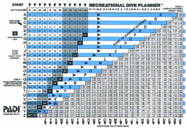
The PADI (Professional Association of Diving Instructors) recreational dive planner (dive table) has three tables. Table 1 gives the maximum amount of time the diver can stay at a certain depth on the first dive, and it also indicates how much nitrogen the diver has in in the tissues after a dive. Table 2 is concerned with the diver's surface interval time (how long a diver must remain at the surface before the next dive), and Table 3 allows the diver to determine safe diving limits on the next dive. (Photo: PADI)
|
dive table - dive tables present dive times for specific depths, adherence to which, the scuba diver can avoid contracting decompression sickness (the bends). The theory behind dive tables is based on our understanding of how nitrogen is taken up on compression (descent) and given off on decompression (ascent). The first dive tables were devised by John S. Haldane in the period 1906-1908 |
divergent evolution - the evolution from one species of organism into a number of different species. As the original population increases in size, it spreads out from its center of origin to exploit other habitats and ecological niches. In time, this results in a number of populations, each adapted to its particular habitat. Eventually these populations, genetically may differ from each other sufficiently to become new species. Divergent evolution has also been termed "adaptive radiation" |
diversity index - a mathematical index of species diversity within a community |
diverticulum - a blind sac branching off a cavity or canal |
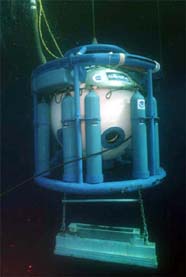
The SAT system diving bell is raised to the surface after an eight hour dive on the wreck of the USS Monitor. The bell is the divers' "taxi" between their topside saturation living quarters and their work site, some 240 ft below the surface. (Photo: official U.S. Navy photo by Photographer’s Mate Chief Petty Officer (DV/SW) Andrew McKaskle)
|
diving bell - a hollow, usually inverted vessel, such as one used for diving deep in a body of water. It is open on the bottom and supplied with air under pressure. During the Monitor 2001 Expedition, navy divers utilized a 12-person, two-chamber saturation system with a two-person closed diving bell. The system can operate as deep as 1,500 ft—considerably deeper than the Monitor, which rests on the sea floor at a depth of 235 ft. Saturation systems are often used in deep-water situations (below 200 ft) in order to reduce the time lost to decompression during the slow ascent to the surface required for preventing decompression sickness |
division - in botanical nomenclature, "division" is used instead of "phylum", and is equal in taxonomic status to the phylum |

Graphic of DNA shows the spiral double helix structure of the molecule.
|
DNA (deoxyribosenucleic acid) - also termed deoxyribonucleic acid. The molecule that encodes genetic information in the cells. It resembles a double helix held together by weak bonds of four nucleotides (adenine, guanine, cytosine, and thymine) that are repeated ad infinitum in various sequences. These sequences combine into genes that govern the production of proteins. The DNA located within the nuclear membrane of eukaryotic cells is sometimes referred to as nDNA |
DNA annealling - the reformation of double stranded DNA from thermally denatured DNA. The rate of reassociation depends upon the degree of repetition and is slowest for unique sequences |
DNA barcode - DNA barcoding is a taxonomic method which uses a short genetic marker in an organism's mitochondrial DNA (mtDNA) to quickly and easily identify it as belonging to a particular species. This approach to species identification has its supporters and detractors |
DNA chip - a small piece of glass or silicon that has small pieces of DNA arrayed on its surface |
DNA fingerprinting - a method employed to determine differences in amino acid sequences between related proteins. It is used especially for identification by extracting and identifying the base-pair pattern of an organism's DNA |
DNA hybridization - the process of joining two complementary strands of DNA, or one each of DNA and RNA, to form a double-stranded molecule; a technique in which single stranded nucleic acids are allowed to interact so that complexes or hybrids are formed by molecules with sufficiently similar, complementary sequences. By this means the degree of sequence identity can be assessed and specific sequences detected |
DNA library - a collection of cloned DNA fragments that collectively represent the genome of an organism |
DNA ligase - an enzyme that rejoins cut pieces of DNA |
DNA marker - segments of chromosomal DNA known to be linked with heritable traits or diseases. Although the markers themselves do not produce the conditions, they exist in concert with the genes responsible and are passed on with them |
DNA polymerase - an enzyme that replicates DNA. DNA polymerase is the basis of PCR ( polymerase chain reaction) |
DNA probe - in genomics, the DNA affixed to a microarray; a small piece of nucleic acid that has been labeled with a radioactive isotope, dye, or enzyme that is used to locate a particular nucleotide sequence or gene on a DNA molecule |
DNA replication - DNA replication or DNA synthesis is the process of copying the double-stranded DNA prior to cell division. The two resulting double strands are identical (occasionally errors (mutation) in replication can result in a less than perfect copy) and each of them consists of one original and one newly synthesized strand |
DNA sequence - the order of nucleotide bases in the DNA molecule |
DO (dissolved oxygen) - the concentration of free oxygen dissolved in water and readily available to aerobic organisms. DO is usually expressed in milligrams per liter, parts per million, or percent of saturation |
Dobson Unit (DU) - the unit of measure for total ozone or other gases |
DOC (dissolved organic carbon) - a measure of the organic compounds that are dissolved in water |
DODS (Distributed Oceanographic Data System) - see "OPeNDAP" |
Dolastatin 10 - a marine pharmaceutical extracted from the marine sea hare (a snail) Dolabella auricularia. It is an anti-cancer drug which interferes with cell division processes |
dolioform - barrel-shaped |
doliolaria larva - the larval stage of sea cucumbers immediately following the auricularia stage. It is cylindrical in shape and possesses five transverse bands of cilia |
dolomite - a sedimentary rock, similar to limestone, composed largely of calcium magnesium carbonate (CaMg (CO3)2) |
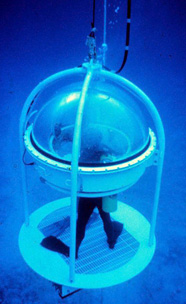
Divers in the air-filled diving bell dome can talk to each other and to the surface scientists. (Photo: NOAA/NURP)
|
dome-shaped - a form that resembles half of a sphere |
dominant species - a species which make up a large proportion of a community in terms of its biomass or numbers of individuals |
domoic acid - an acidic cyanotoxin found associated with certain diatom blooms. Domoic acid can bioaccumulate in marine organisms that feed on the phytoplankton, such as shellfish and some fishes. In mammals, including humans, domoic acid is a neurotoxin responsible for Amnesic Shellfish Poisoning (ASP) , causing short term memory loss, brain damage, and in severe cases, death |
doppler radar - radar that can measure radial velocity, the instantaneous component of motion parallel to the radar beam (i.e., toward or away from the radar antenna) |
doppler shift - the change in the tone of a sound caused by the sound source moving away or towards the listener |

This dorid nudibranch (Chromodoris kunei) feeds on sponges and stores their toxic chemicals in its body for protection. Its striking coloration advertise that it is not good to eat. (Photo: Ocean Futures Society/Richard C. Murphy)
|
dorid nudibranch - a type of nudibranch (order Nudibranchia) possessing a feather-like external gill on the back and a rhinophoral sheath. The mantle is thick and extends over the foot. The surface of the mantle may bear tubercles which vary in size, shape and number, and are often a taxonomic diagnostic character |
dormancy - a period of suspended growth and metabolic activity. Many plants, seeds, spores, cysts, and some invertebrates become dormant during unfavorable conditions |
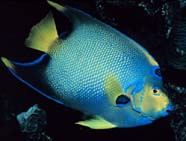
The upper or back surface of this queen angelfish is the dorsal surface, as opposed to the opposite belly surface, which is the ventral surface. (Photo: Chris Huss, Florida Keys National Marine Sanctuary)
|
dorsal - refers to the upper or back surface of an animal |
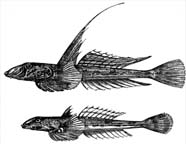
Dragonets, such as Callionymus lyra, exhibit strong sexual dimorphism in the dorsal fin (male [top] and female [bottom]). (Image: NOAA)
|
dorsal fin - in fishes, one or more fins situated on the midline of the back, having spines or rays, sometimes both; excludes the adipose fin found in some fishes, such as catfishes and salmon |
dorsoventral - an axis extending from the dorsal to ventral surface of an animal body |
dot grid - a technique used to analyze a photograph of a quadrat (photo-quadrat), in which a grid of random dots is placed over an image of the photo-quadrat. It assumes that the proportion of dots that lies on a substrate is equal to the proportional area of the substrate |
double helix - the normal structural configuration of DNA consisting of two helices winding about the same axis. The structure of DNA was first proposed by Watson and Crick (1953) with two interlocking helices joined by hydrogen bonds between paired bases |
doubling time - the length of time required for a population to double in size |
download - transferring data (usually a file) from one computer to another. The opposite of "upload" |
downstream - in the direction of the water movement |
downwelling - a downward current of surface water in the ocean, usually caused by differences in the density of seawater |
drag - the frictional impedance (retarding force) acting on an object moving through a fluid parallel and opposite to the direction of motion |
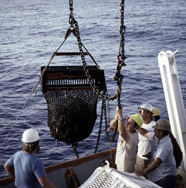
Scientists recover a chain dredge. (Photo: Joseph Schebal /NOAA)
|
dredge - a metal collar with an attached collecting bag that is dragged along the bottom to obtain samples of rock, sediment, or benthic organisms |
dredging - a method for deepening streams, swamps or coastal waters by scraping and removing solids from the bottom. The resulting mud is usually deposited in marshes in a process called filling. Dredging and filling can disturb natural ecological cycles. For example, dredging can destroy coral reefs and other aquatic life; filling can destroy the feeding and breeding grounds for many fish and invertebrate species |
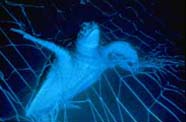
A marine turtle is caught in a drift net. (Photo: NOAA)
|
drift net - a fishing net, often miles in extent, arranged to drift with the tide or current and buoyed-up by floats or attached to a boat |
drop net - a small, usually circular net with weights around the perimeter and a float in the center |
drop root - an adventitious root in mangroves that originates from the branches, and roots in the surface-sediments |
drowned reef - a coral reef that grew too slowly and became covered by deeper and deeper water until the reef received too little light to support reef growth altogether; see "give-up reef" |
drowned river - a former river inundated by a rise in sea level in past times |
Drupella - a genus of Indopacific muricid gastropod that preys almost exclusively on living coral tissues. Some, if not all of these corallivorous species, release a proteolytic enzyme in their saliva that partially digests its prey. Drupella species may cause considerable damage to reefs |
dry weight - the moisture-free weight of a biological sample obtained by drying at high (oven-drying) or low (freeze-drying) temperatures for an time sufficient to remove all water |
dsRNA (double stranded RNA) - long double-stranded RNAs (dsRNAs; typically >200 nt) can be used to silence the expression of target genes in a variety of organisms and cell types |
duct - any tubular structure |
duplex DNA - double-stranded DNA |
DVD-ram - a high-capacity, high-performance optical disk that allows data to be read, written, and erased. It is comparable to a rewritable CD, and can hold up to 2.6 gigabytes of information per side |
dychotomic growth - growth of a coral colony in which the corals divide symmetrically. Since all polyps grow simultaneously, neighboring polyps are the same age |
dynamic optical demarcation - in animal behavior, a special signalling device used by an animal in a stereotypical movement, as for example, the waving of a fiddler crab's claw to attract the attention of other members of its species |
dyne - unit of force to accelerate 1 gram to 1 cm per second per second |
dysidotronic acid - an antiinflammatory drug derived from marine sponges in the genus Dysidea |
|
|
|
|

